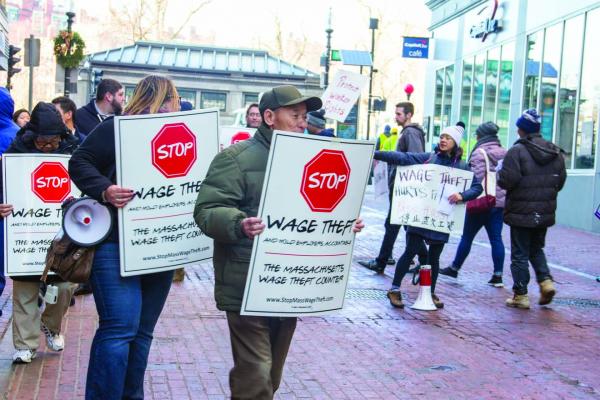A new study, published in the Journal of Epidemiology, links exploitation to mental illness. The authors, Seth Prins and colleagues at the Columbia University in New York City, go beyond the link between socioeconomic status and mental disorder to investigate the role of abusive power dynamics fostered by an economic system that enables overwork and wage theft.
“Focusing on exploitation rather than its consequences (e.g., socioeconomic status) shifts attention to a structural process that may be a more appropriate explanatory mechanism, and a more pragmatic intervention target, for mental illness,” Prins and his co-authors explain.
The article, ’The Serpent of their Agonies’: Exploitation as A Structural Determinant of Mental Illness,” is titled after the following quote found in Marx’s Capital.
“For protection against ‘the serpent of their agonies,’ the laborers must put their heads together, and, as a class, compel the passing of a law, an all-powerful social barrier that shall prevent the very workers from selling, by voluntary contract with capital, themselves and their families into slavery and death.”

Social stratification is a well-documented determinant of mental health. Poverty and inequality are connected to high rates of suicide and increased diagnoses of mood disorders and schizophrenia. However, for this study, the authors choose to shift their focus away from the psychological ramifications of alienation and powerlessness and instead emphasize that “workplace domination” is just as deleterious to our mental health and wellness.
There are significant advantages to shifting the scope away from alienation toward exploitation. A key advantage, according to the authors, is that if direct measures of exploitation and their correlation to mental ill-health exist, it “would strengthen confidence in relational class theory and suggest more fundamental targets for intervention…shifting the attention to a structural process that generates social and economic inequality.”
Unfortunately, direct measures of exploitation are rare. The authors sought to find an instance of “unconcealed exploitation” that could be operationalized. To do so, they conceptualized unpaid hours of work, known colloquially as wage theft, to capture the intricate dynamics of unconcealed exploitation and then determine whether they are associated with psychological distress and mental illness.
With the data from the 1983-2017 waves of Panel Study Income Dynamics, which utilized a six-question scale designed to estimate the prevalence of serious mental illness in full-time (40 hours per week) head of household respondents, the authors had a nationally representative working-class cohort.
After controlling for confounding variables and alternative explanations, the results revealed that as unconcealed exploitation increased, psychological distress and mental illness also increased. Specifically, they found that for each unit increase in unconcealed exploitation, psychological distress increased by 1.6 points (95% CI: 0.71, 2.5) on the K6 scale, and the odds of mental illness tripled (OR: 3.0, 95% CI: 1.5, 6.1).
More analysis and research should be conducted to determine whether these results are replicable when an intersectional lens is applied.
The authors suggest that we shift from placing the responsibility on individual workers to sustain a positive work-life balance to maintain their mental health and, instead, point toward labor unions and workplace democracy to address worker exploitation directly.
****
Prins, S. J., McKetta, S., Platt, J., Muntaner, C., Keyes, K. M., & Bates, L. M. (2020). “The Serpent of their Agonies”: Exploitation As Structural Determinant of Mental Illness. Epidemiology.















“Overwork and Exploitation Linked to Psychological Distress.” Dah, another statement of the blatantly obvious, which needs to be pointed out to a lot of totally DSM deluded “mental health” workers.
And I was told by my former Lutheran, child abuse covering up, psychologist that “all distress is caused by a chemical imbalance” in my brain alone. And a second Lutheran psychologist, who was subsequently sicked upon me, who attempted to steal all my money and work, because my work was “too truthful” for him, and his child abuse profiteering “profession” and religion.
He rationalized his attempted thievery by claiming “all the money should be put in the hands of a small number of bankers.” And his goal in life was to “maintain the status quo,” which is NOT a good idea at this point. But this all means that some of the, systemic child abuse covering up, criminal psychologists, still do need to be re-educated.
But I do agree, we do need to “shift from placing the responsibility on individual workers to sustain a positive work-life balance to maintain their mental health and, instead,” de-medicalize our societies. We absolutely need to get the scientific fraud based “mental health” industries out of the business of claiming “all distress is caused by chemical imbalances” in individuals’ brains.
And we need to get the psychiatric/ medical/ pharmaceutical industrial complex out of the business of attempting to monopolize our entire society, under their scientific fraud based systems.
Report comment
In other news, death threats are noted to increase anxiety, and permanent incarceration in a dungeon without charge or hope of release has been linked to depressed mood. It is noted that not all respond to death threats with anxiety, and is postulated that this reaction is due to a chemical malfunction in the region of the amygdala which amplifies the fear response. Of course, those who don’t experience increased anxiety score high on tests of psychopathy, but hey, it seems like psychopaths are better equipped to deal with direct threats to their welfare, which is quite adaptive when confronting other psychopathic killers.
Report comment
Thank you, Steve
Report comment
IMO the 1 percent of people at the top need good looking servants to look after them and other professionals to do their bidding and thats about it!
85 percent of the work people do, could be reorganised and automated – this work is preserved to keep people occupied.
Report comment